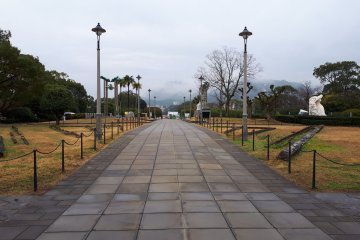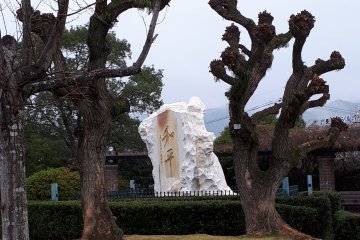On the 1st of April 1955, the city of Nagasaki unveiled a monument to the 74,000 victims of the world's second atomic weapon used in war. The statue, a giant 9.7 metre bronze one weighing 30 tonnes, has become a focal point of the city's annual Peace Ceremony, held on August 9 each year. The statue itself was designed by the late Kitamura Seibo, a native artist of Nagasaki.
What strikes the visitor most is that Kitamura's creation mimics the power and aesthetics of the world that Japan had found itself pitted against during those tragic years of World War II. The official interpretation of the statue is that the seated man's right arm, pointing straight to the sky, represents the threat of atomic and nuclear weapons. His left arm, extended out horizontally, symbolises peace. The eyes are closed in mourning for the victims.
The sheer size and bulk of Kitamura's work is impressive - you cannot not pay attention to it. But along with this most iconic of memorials visitors to the Peace Park will find many more monuments to peace, harmony and hope in the park's Peace Symbols Zone.
Established in 1978, the zone features works donated by various nations from around the world: these include the Anangu aboriginal communities of Australia's 2016 gift, 'Tree of Life: Gift of Peace'; Turkey's 'Infinity', a figure of a man and woman holding hands donated in 1991; a 2006 work from New Zealand titled 'Cloak of Peace'; and a 1983 statue of a mother protecting her child, from Nagasaki City's sister city of Middelburg in The Netherlands.
Nagasaki Peace Park is a dutiful reminder of the past with a hopeful tinge for a more reasonable future.










